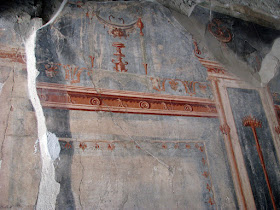After taking just a few steps down the center of Cardo IV and looking left, this is what I saw. The business that was on the corner of Decumano Massimo and Cardo IV obviously had pipes. I am not clear if these pipes brought in water or took out waste, but they are clearly pipes.
Here, I have taken a few more steps and turned to look back at those pipes. I have read that the human remains found in Herculaneum contained some amount of lead, likely from the lead pipes used in the city.
I have simply turned around again for this photo, my back once again to the Forum.
Turning to the left once more, I am looking into a residence. The photo appears to be taken at floor level because I am standing in the street, which is much lower than the sidewalk here (see the preceding picture). Having done my research for this post, I now know that this is the famous Casa del bel Cortile, or House of the Beautiful Courtyard. We did not go in. I don't know why we did not go in, but I really wish we had. The photos I have found on the internet are superb, especially the tile floor. In addition, this home apparently contains the most famous skeletal remains in southern Italy. Here is a quote I found online from someone who did go in: "we...ducked into a side room a there it was - silently deafening. In the middle of the room stood a table on which lay the skeletons of a couple. They were hunched in the fetal position, clawing and clutching at each other. A split second after they embraced, some 2,000 years ago, they were engulfed by boiling mud."
I have found no photos of the couple taken by tourists - maybe it seems an invasion of privacy to take one. But I did find an excellent 360 degree photo from the next room, and you can see the display of which they speak from a distance.
On the left side again, we see a particularly well preserved building.
Another shot of it. This shot shows preservation and restoration in the same shot. The beams on the far left are replacements. The original beams are encased in glass (or is it plastic?).
We finally find our way in to the portico area we saw before and find we are in the home of Salone Nero. Fragments of the documents of L. Vennidius Ennychus were found in this house. While it is hard to determine exactly what the fragments state, it appears that Vennidius was found unworthy to hold (run for?) office and he was contesting that status by requesting an arbiter.
Now turning the camera slightly more to the left we see more of the portico. As you can see, this was a house of pretty significant size.
We'll now look into a few of the rooms on the left side of this photo.
The fresco painting has survived in this room in pretty good condition. It is fairly complete and the colors still come through.
A close-up of one of the fragments in the room, showing the thickness of the fresco.
Another detail.
Turning around to look out the doorway.
We've now walked northward somewhat and are in the House of the Black Hall as shown on the map (Casa del Salone Nero is just below this on the map). The frescoes in this room are similarly well preserved.
A close-up of some of the details on this wall...
Twenty wax tablets owned by Lucius Venidius Ennychus, a former slave, were found in this room. These tablets described the business that went on in the house. The business was either managed by or owned by Lucius.
More close-ups....
Is this a coat rack?
And finally, the two of us. Not the best picture in the world, but we had been walking around in the warm sun about half a day at this point. And we were still smiling!























No comments:
Post a Comment